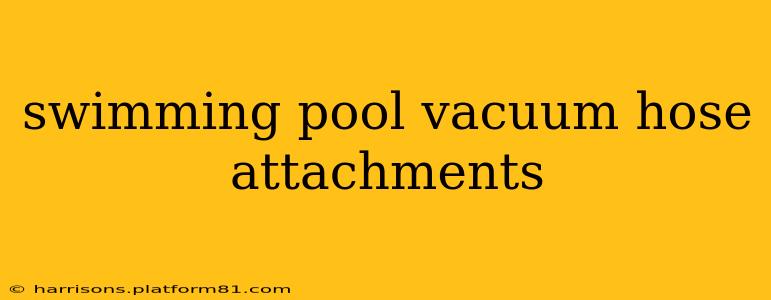Keeping your swimming pool sparkling clean requires the right tools, and a vacuum hose with the appropriate attachments is crucial for effective cleaning. This guide explores the various types of swimming pool vacuum hose attachments, their functionalities, and how to choose the best ones for your needs. We'll cover everything from basic leaf rakes to specialized crevice cleaners, ensuring you have the knowledge to maintain a pristine pool environment.
What are the Different Types of Swimming Pool Vacuum Hose Attachments?
Several attachments cater to different cleaning needs. Choosing the right one depends on the type of debris you’re dealing with and the areas you need to clean.
Common Attachments Include:
-
Leaf Rake: This attachment is ideal for collecting large debris like leaves, twigs, and other larger items from the pool floor. Its wide, open design effectively gathers substantial amounts of debris.
-
Crevice Tool: Specifically designed for cleaning narrow areas like pool steps, corners, and crevices, where a standard vacuum head might struggle to reach. Its slim profile ensures thorough cleaning in tight spaces.
-
Floor Brush: Often included as a standard vacuum head, the floor brush is designed for general pool cleaning. Its bristles loosen and agitate dirt and grime embedded in the pool floor, allowing for easier suction.
-
Sidewall Brush: Similar to the floor brush, this attachment is designed for cleaning the pool walls. It features bristles optimized for cleaning vertical surfaces, removing algae and grime buildup.
-
Pool Vacuum Head: This is the main attachment that connects to the vacuum hose. It provides the suction needed to pick up debris, often working in conjunction with the floor or sidewall brushes.
What Types of Debris Can Each Attachment Clean?
The effectiveness of each attachment depends heavily on the type and size of debris:
-
Leaf Rake: Best for large debris like leaves, large twigs, and other bulky items. Not suitable for fine dirt or algae.
-
Crevice Tool: Perfect for cleaning grout lines, steps, and other hard-to-reach corners, tackling small debris that might otherwise be missed.
-
Floor Brush: Effectively cleans general pool debris, including small particles of dirt, sand, and organic matter. Also helps loosen algae and other stubborn contaminants.
-
Sidewall Brush: Cleans algae and grime from pool walls and steps, leaving surfaces looking clean and refreshed.
-
Pool Vacuum Head: The main tool for collecting the debris removed by other attachments. Often works in conjunction with other attachments for optimal cleaning.
How Do I Choose the Right Vacuum Hose Attachments for My Pool?
Selecting the right attachments depends on your pool's size, shape, and the types of debris you commonly encounter. Consider these factors:
-
Pool Size and Shape: Larger pools might benefit from a wider leaf rake or a more powerful vacuum system. Pools with intricate shapes require attachments like crevice tools for thorough cleaning.
-
Debris Type: Pools with heavy leaf fall necessitate a leaf rake, while pools prone to algae require floor and sidewall brushes.
-
Budget: While higher-end attachments might offer superior performance, basic attachments are sufficient for many pools.
-
Your Pool Cleaning Frequency: More frequent cleaning might justify investing in a comprehensive set of attachments.
How Often Should I Clean My Swimming Pool?
The frequency of pool cleaning depends on several factors, including weather, usage, and the presence of trees or other debris sources. As a general rule, most pools benefit from at least weekly cleaning, with more frequent cleaning necessary during peak seasons or periods of heavy use.
What are the Best Practices for Using Swimming Pool Vacuum Hose Attachments?
-
Always pre-clean the pool: Remove large debris manually before vacuuming.
-
Check for clogs: Regularly inspect the hose and attachments for clogs that might impede suction.
-
Proper storage: Store attachments in a clean, dry place to prevent damage and prolong their lifespan.
-
Regular maintenance: Clean and inspect attachments regularly to ensure they are functioning properly.
By understanding the different types of swimming pool vacuum hose attachments and how to use them effectively, you can keep your pool clean, safe, and enjoyable for years to come. Remember that choosing the right attachments is a key step in maintaining a sparkling and healthy swimming environment.
